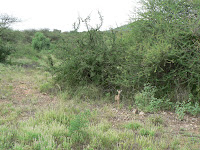To Samburu, Seeking Albert



The final leg of this trip was a return to Samburu, Kenya. I wanted to see again an elephant that I was lucky enough to see born in October of 2005 on my first visit to Samburu. An elephant birth in the wild is so incredibly rare to catch that seeing the birth was so far my favorite day EVER. I knew there was a group called Save the Elephants doing research in Samburu, so I had sent them the pictures of the birth when I got home. They said they had a radio collar on an elephant in the same family group and therefore it may be possible to keep track of the baby elephant. The family is known as the Royal Family, and the mother of the calf was Cleopatra. The matriarch of the group was Victoria. So, they let me name the baby (even though usually they don't name them until they are teens), and I named him Albert. Since I was in Uganda, next door, I didn't feel it would be fair to not stop by to try and see Albert again.
I had seen Albert on day one and day three of his life in this world, and I was headed back to try and see him at about eighteen months. Unfortunately, upon arrival in Samburu I learned that Albert had suffered a broken leg about eight months ago. It has healed up fairly well, but he suffered terrible pain and had to be assisted by his mother to even walk for quite some time. He also survived a terrible drought in his first year of life, when he was at his most vulnerable. The good news is he lived; the bad news is he suffered.
I stayed at a camp affiliated with Save the Elephants, known as Elephant Watch Camp. This is the nicest camp I've ever stayed in. It's stunning in every respect. The staff, local Samburu, seem to have a great time working there and as a result, they are fun to be around. The food is excellent. The setting is superb. Your bed looks out on the river. Animals wander through camp. You have a lovely porch and tent, and the best part is the outdoor shower and bathrooms. The outdoor restroom & shower facilities are really incredible, the best I've ever seen in my travels to date. Yes, it is a bit costly, but wow, is it an experience. Also, as they are affiliated directly with research, you get incredible information here. I was really lucky to meet a very, very nice lion researcher who was kind enough to play hostess for me, as I was the only one in camp and it would have been a bit boring to dine alone all the time. I really enjoyed talking with her about the area, her research, her prior work at the elephant research center, and her perspective as a native Kenyan.
Day One I didn't see Albert, just got settled into camp and did a few game drives. I saw Samburu in dry season before, and it was completely different in wet season. The brush and grass was tall enough that it was tough to see any animals, and the animals were more spread out throughout the area too. I wanted to see Grevy's zebra, but only saw one, from a great distance, in my two days in Samburu. I did see oryx, gerenuk, impala and LOTS of elephants though, as well as an awful lot of little dik-dik. A dik-dik is pictured above in close up wiggling her nose, and another in the road, as well as one by a bush so you can see they are only about a foot to 18 inches high. Mini-deer! They are so cute. There must be nothing in the world cuter than a baby dik-dik!
One fun thing about game drives with this group is they know all the elephants and have books of photos to identify them, so you know a little more than just the fact you are looking at an elephant as you watch them.
One thing I adore about Samburu is how CLOSE you can get to elephants there. Many other places the elephants are stand-offish, but in Samburu they are very, very comfortable being very, very close to you. It is incredible to sit and watch them, and in the wet season I had a lovely time watching them take baths in the river, play in the mud holes, and generally wander around living their peaceful elephant lives.
Day Two was the quest to find Albert, and that's for the next post.

Comments